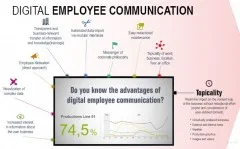The afternoon session was mostly examples of digital signage projects, so we’ve combined several talks into a single article.
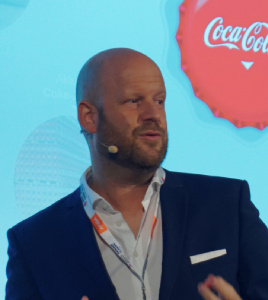 Markus Deserno is one of the Managing Directors of Seen Media which is a full service systems integrator. His topic was Coca Cola and he talked about a project that his company did for the bottlers in Germany. Staff really love to be part of the company which has its own strategy and it likes to communicate often with its staff. However only 66% of the 9500 staff in Coca Cola in Germany have their own screens at work, so digital signage was one way to communicate.
Markus Deserno is one of the Managing Directors of Seen Media which is a full service systems integrator. His topic was Coca Cola and he talked about a project that his company did for the bottlers in Germany. Staff really love to be part of the company which has its own strategy and it likes to communicate often with its staff. However only 66% of the 9500 staff in Coca Cola in Germany have their own screens at work, so digital signage was one way to communicate.
Deserno showed how in some detail his company designed a consistent menu structure for its content.
In the production area, data on current production is shown as well as details of energy and water waste. Coca Cola has 16 bottling companies in Germany and there is a league table based on productivity and this table became part of the communications. The communication strategy helps to give a ‘we are Coke’ feeling to staff as well as delivering information and training.
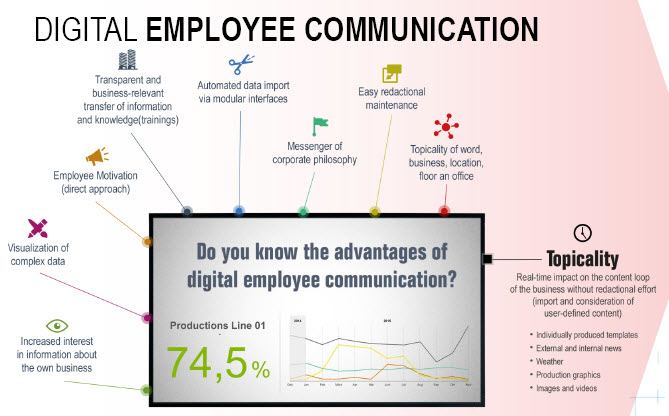
Linda Ralph is from Mood Media is a long-established (80 years) specialist in helping retailers to create the right atmosphere to sell, originally with music, but now in other areas including digital signage and scent. The physical store has ‘never been more important’ as 65% of people say they would prefer to buy in retail than online. Interesting marketing can make the purchase itself more interesting. 95% of apparel and footwear sales are still in stores, Ralph said.
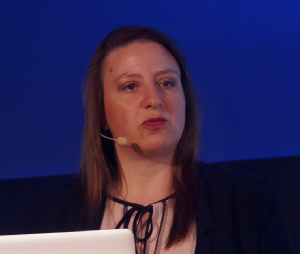 The market is not just about other competitors, it’s about expectations. Uber, Tindr and Whatsapp have transformed customers’ expectations in many areas of their lives. Digital signage is a good addition to the range of technologies because it has motion and gives a ‘shortcut to human emotion’. Digital signage has the highest impact compared to other media, Ralph said. Online advertising is increasing, but so are ad-blockers which can reduce the impact of web advertisint.
The market is not just about other competitors, it’s about expectations. Uber, Tindr and Whatsapp have transformed customers’ expectations in many areas of their lives. Digital signage is a good addition to the range of technologies because it has motion and gives a ‘shortcut to human emotion’. Digital signage has the highest impact compared to other media, Ralph said. Online advertising is increasing, but so are ad-blockers which can reduce the impact of web advertisint.
Waiting in line is the most negative aspect of the in store experience, but digital signage can help reduce the apparent waiting time. You can engage customers in a playful way and customise the instore experience and consultancy.
Ralph showed an example of ING Bank in NL that used digital signage to sell financial services and saw a 40% boost in car insurance sales as a result of a specific promotion. Another retailer was New Look, the clothing retailer, which had a store with a big basement, but shoppers were not going downstairs. Mood Media put a big video wall at the top that pointed downstairs and the company developed a ‘Be a star ‘ photo shoot with a booth where photos can be taken in clothes from the store. These can be emailed but then shown on the big video wall in the store. (We asked about the efficacy of this, but no data is available because of customer confidentiality).
ROPO or research online purchase offline is the new way of buying cars, Ralph said. Buyers typically select a shortlist of three brands then visit retail outlets. Showrooms can be daunting places, so Renault wanted to make the store more like an online experience. There is a configuration area which use iPads or other displays. Buyers can show the configured car on big screens and the system sends a pdf to the consumer.
While that project was intended to be transactional and leading to a sale, Nespresso set up ’boutiques’ that more like a hotel lobby and are supposed to be very high end, to help build the brand. It’s not about the product anymore, Ralph said, it’s the customer experience.
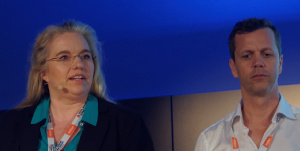 Adrieen Schmidthals is from Valora which runs 1,500 small stores, often in transport hubs, selling press and books and she presented alongside Thorsten Wien of Visualart which is a supplier to the firm. Valora also has a convenience business unit and a tobacco business unit. Visualart supplies content services.
Adrieen Schmidthals is from Valora which runs 1,500 small stores, often in transport hubs, selling press and books and she presented alongside Thorsten Wien of Visualart which is a supplier to the firm. Valora also has a convenience business unit and a tobacco business unit. Visualart supplies content services.
Visualart tried six different channel approaches in 2012 and it tested to find out what worked. In this case, the job was to promote sales – it’s not always the case, but it was this time. Eventually, the firms cut down to two channels, one for direct promotion of products by Valora, but the second has been made available to brands as a kind of DOOH channel. The stores have strong locations with many people viewing the content as they are in stations and other high footfall locations.
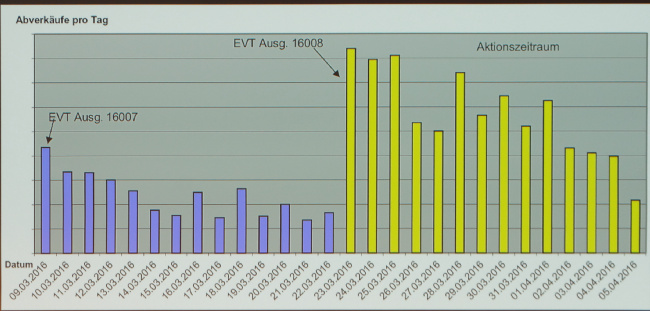 The project helped to boost sales a lot
The project helped to boost sales a lot
The project started with displays in six stores and this was then boosted to 50. Some magazines with special spots saw boosts of 20% in sales – so were considered a good success. “Content is King”, but the key is developing a channel, so there is a lot of pressure to push clients to use VisualArt to create that content so that the channel is quite consistent.
 Sascha Martini of Razorfish talked about Enhanced Reality is an interesting innovation that is in the early stage. He showed an image from Magic Leap but said that there should be ubiquitous use of this kind of technology in the future. Many see the smartphone as the most sophisticated technology, but it’s not – we are becoming smarpthone zombies. As technology gets better, life should get simpler, but doesn’t.
Sascha Martini of Razorfish talked about Enhanced Reality is an interesting innovation that is in the early stage. He showed an image from Magic Leap but said that there should be ubiquitous use of this kind of technology in the future. Many see the smartphone as the most sophisticated technology, but it’s not – we are becoming smarpthone zombies. As technology gets better, life should get simpler, but doesn’t.
Gartner has forecast that 80% of transactions will be performed using enhanced reality and McKinsey said that $11 trillion will be added to the global economy by the technology by 2025. Maritini looked at Gartner’s hype curve and said that augmented reality may be “past the bottom” and on its way towards the plateau of productivitiy. Head-mounted displays will be a huge market, he believes.
VR is immersive and is a ‘personal bubble’ and disconnects you from the real world. It also includes audio and adds gloves with feedback etc. However, enhanced or augmented reality adds to your information about the world. Google glass was over promised but Microsoft Hololens is interesting. It is truly wireless, unlike other systems and could transform the market. Many believe that VR will be as big as consoles as an opportunity, but AR will be as big as mobile. Martini then went through the devices in the market and developments. He said that it is difficult to make apps as content creation is in the very early stages.
“Why talk about these technologies at a digital signage event”, Martini asked? Because it will impact content, was his answer. He gave example based on watching NFL sports and getting information “in the room”. Maryott hotels are already offering “virtual honeymoons” to sell destinations. The travel industry opportunity is very clear, but there will be many others, including automotive.

 Rastislav Brencic is from Enplug Europe which is a division of an LA-based company started in 2012 which is involved with ‘Public Computing’ . The PC market evolved as personal, then mobile computing. Reduced pricing drove big volume. Now, in his view, public conmputing will grow based on LCD price drops. Everybody wants everything now and to be connected, Brencic said. You need two way communications with a device, not just a public display. Custom content is more appealing and useful and he believes there is a “huge opportunity” to connect the offline with the online.
Rastislav Brencic is from Enplug Europe which is a division of an LA-based company started in 2012 which is involved with ‘Public Computing’ . The PC market evolved as personal, then mobile computing. Reduced pricing drove big volume. Now, in his view, public conmputing will grow based on LCD price drops. Everybody wants everything now and to be connected, Brencic said. You need two way communications with a device, not just a public display. Custom content is more appealing and useful and he believes there is a “huge opportunity” to connect the offline with the online.
Digital can save print cost and increase impressions. Enplug wants to create open platform. Brencic then went through a quick fire list of projects his company has been involved in.

